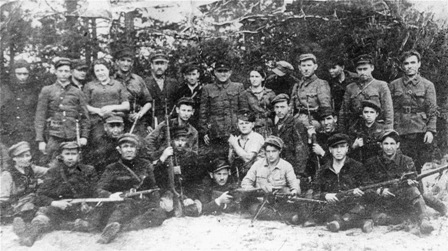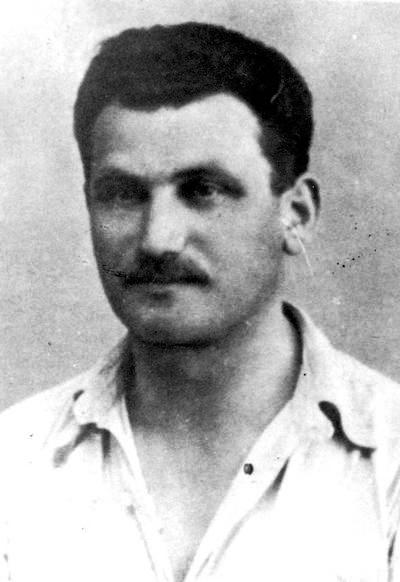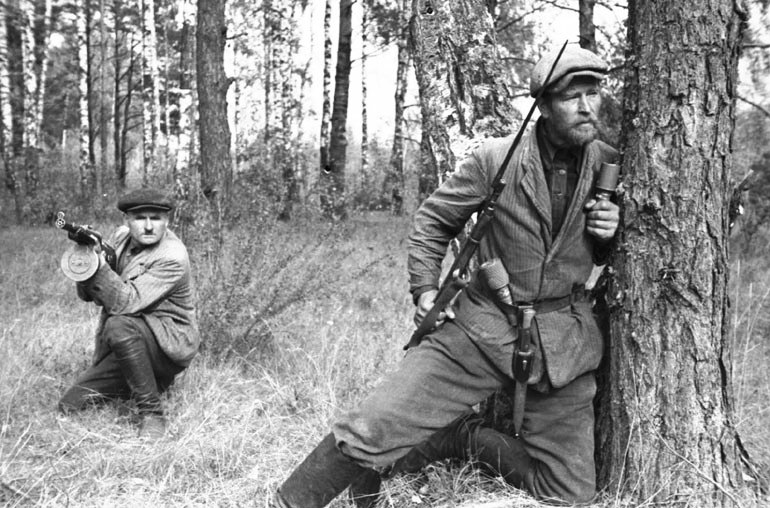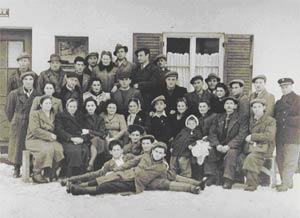The Bielski partisans were also affiliated with Soviet partisans in the vicinity of the Naliboki Forest under General Platon, and several attempts by Soviet partisan commanders to absorb Bielski fighters into their units were resisted. This meant that the Jewish partisan group retained its integrity and remained under Tuvia Bielski's command, allowing him to continue his dedication to protect Jewish lives along with engaging in combat activity.
Holocaust Education & Archive Research Team |
Revolt & Resistance
Acts of Resistance
Jewish Resistance
Groups Jewish Resistors Allied Reports Anti-Nazi Resistance Nazi collaborators
| |||||
The Bielski Brothers Jewish Resistance and the "Otriad"
Prior to the onset of WWII, conditions throughout occupied Poland & Belarus varied greatly. In some areas, especially in eastern Poland, which the Soviet Union invaded in 1939, and subsequently "formally" annexed, the situation was particularly volatile.
During the two year' occupation till the Soviet-German war outbreak in 1941, the Soviets carried out the ethnic cleansing of Poles considered as a potential threat to full annexation of these territories into Soviet Union.
Hundred of thousands of Polish officials, officers, soldiers, policemen, teachers, churchmen, landowners, and civilians with their families were sent to Siberian concentration camps.
Charles Bedzow from Lida, a city northeast of Novgrudek said the following:
"I remember we were very happy that the Russians liberated us from the anti-Semitic government of Poland, and we were happy that the Germans didn't occupy our area of Belarus, but when the Russians came in, right away they took away my father's business. I was forced to go to a Russian school, instead of the Tarbut. The Russians forced my father to work for them. He was sweeping the floors because he was a capitalist, a bourgeois. He worked in his own store as a laborer...
Then came Operation Barbarossa
In the village of Stankevich, Belarus, Tuvia Bielski was sound asleep when the sounds of gunfire woke him from his slumber. From his window he could see smoke and burning buildings. Everywhere in the streets he could see people were running in a mad panic for any type of shelter they could find.
It was the month of June, 1941 and Nazi Germany along with its Axis allies invaded the Soviet Union and all of eastern Poland and present-day Belarus territory was soon to be occupied by the Germans within two months.
The Nazi's imposed a brutal racist regime, burning down some 9,000 Belarusian villages, deporting some 380,000 people for slave labor, and millions of civilians. At least 9,000 Belarusian settlements were destroyed by the Nazis. Over 5295 settlements were burned with their entire population and some or all their inhabitants killed. Almost the whole Jewish population of Belarus which did not initially evacuate was killed. The Bielski family were millers, successful farmers and entrepreneurs. The brothers - Tuvis, Zus and Aasel were to lose their parents and siblings to the cruelty of the Nazis, which began with the creation of ghettos and led on to mass slaughters such as one in which 5,500 people were herded to the outskirts of Lida and machine-gunned into large trenches. There were three trenches for children. Nazi commanders were observed shooting children with their pistols.
The surviving Bielski family member became the de facto leaders of a resistance movement that started when they were forced to flee their home. But the Bielski's were more than that. These were all men of incredible will and personal strength who were born to lead others. They insisted on absolute obedience from anyone who wanted to join them, and their credo became not merely to resist, but to save lives.
The guiding philosophy of Tuvia Bielski and other leaders of the Jewish resistance was that all Jews must be protected. Saving Jews superseded taking revenge against the Germans. Women, children and the elderly were accepted in the unit, including Jewish refugees who had fled other partisan units or the ghettos.
The younger men in the unit took incredible risks on food missions to assure that everyone in the unit would have food. What point could there be in resistance if they left any Jew behind?
Constantly moving the community to new forest locations to avoid detection over the years, something that became more and more difficult as the population grew to about a thousand people, the Bielskis found themselves fighting on four fronts and they were never "safe." The immediate threat was from the Germans and the local police, but they were also in danger from local peasants, many of them collaborators, who were willing to turn them in, rather than supply them with food.
They had to be constantly on the alert, they made connections with the Russian partisans, to whom they appeared sufficiently "Communist" and to these men they did not reveal their adherence to Jewish traditions, which would have made Tuvia's important relationship with the partisans suspect. Most of all, they had to guard against internal dissension. The group was far from a "utopian community of enlightened democratic and egalitarian governance," and were forced to extremes measures in order to eliminate dissension and ensure the survival of the group as a whole. By the early spring of 1942, the brothers managed to form what was called an Otriad (a partisan detachment), which initially consisted of their immediate surviving relatives and close friends. Over the next three years, approximately 1200 Jews came into their Otriad. In contrast to Russian partisan units and many of the other Jewish units that restricted participation to young men capable of fighting, the Bielski’s took in any Jew who sought their help and actively helped liberate Jews from nearby ghettos to join the unit. There were enormous strains of life in the forest that the Otriad dealt with on a daily basis. Women needed to worry about their basic survival. Unattached women faced more dangers than those with lovers, and, on several occasions, women took lovers for the express purpose of gaining safety. There were very few children in the community. Women were often encouraged to have abortions in order to prevent extra burdens on the Otriad resources.
At its height, the Otriad camp consisted of long, camouflaged dugouts for sleeping, a large kitchen, a mill, a bakery, a bathhouse, two medical facilities, a tannery, a school, a jail, and a theater. Tailors, seamstresses, shoemakers, watchmakers, carpenters, mechanics, and experts in demolition provided the 1200-member community with necessary skills, and about sixty cows and thirty horses provided food and transportation. Many of the men served as part of the armed contingent which secured food and engaged in sabotage and even the murder of Germans officials, while many others, including the women, the elderly, and the handicapped received the benefits of the community which protected them, despite the difficulties they presented when it was necessary to travel to new locations. Tuvia Bielski reflects on a visit by Soviet Partisan General Platon:
The Bielski Partisans felt it necessary to ruthless in order to ensure their survival. Collaborators who turned in partisans to Nazi authorities were executed after cursory investigation.
A group of German soldiers who surrendered to the Bielskis were summarily executed, presumably because there was no way for the partisans to keep prisoners in the field, but also because many partisans, who had suffered the loss of family at the hands of the Nazis, frankly sought revenge. Ruthlessness sometimes extended to their own: In at least one instance, Zus Bielski executed one of his own officers for leaving a civilian behind, because the Bielski partisans maintained a non-negotiable policy of protecting Jewish civilians.
The Bielski partisans were later accused of war crimes on the neighboring population; particularly for involvement in the massacre of 128 people in the Polish village of Naliboki. They were also charged by Polish officials of numerous cases of armed robbery and looting. Despite their survival method, more than 1000 "Bielski Jews" emerged triumphantly from their forest encampment as a testimony to their resistance to the Nazi tyranny and campaign of murder. Few of the former Otriad were then eager to stay behind in the Soviet Union, many migrated to the United States, Israel and other countries in Western Europe. Tuvia Bielski sank into obscurity although those he rescued continued to admire him. He first settled first in Israel, where he owned a taxi. Later, he moved to the United States, where he drove a truck; he owned two trucks by the end of his career. Until the end of his life, he thought of his years in the Otriad as the most important time of his life.
Sources:
The Bielski Brothers by Peter Duffy HarperCollins; ISBN: 0066210747 2003 Yad Vashem Simon Wiesenthal Center
Copyright 2008 Carmelo Lisciotto H.E.A.R.T
|





